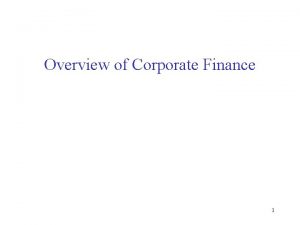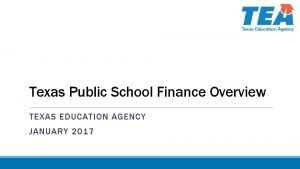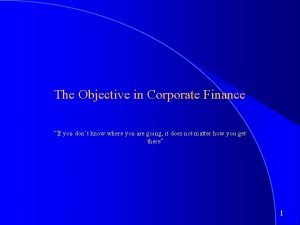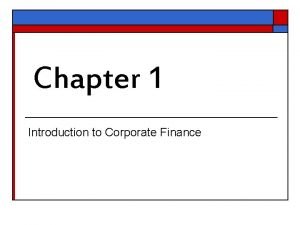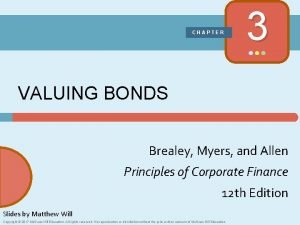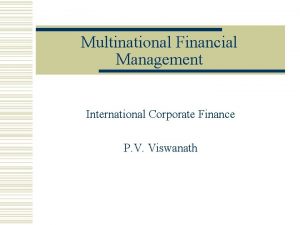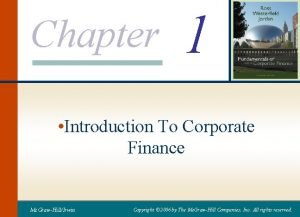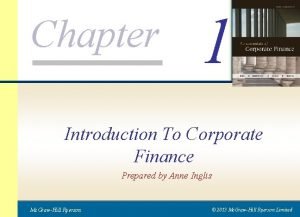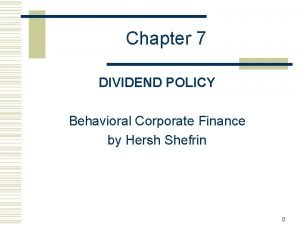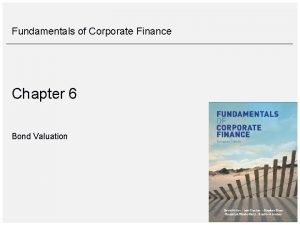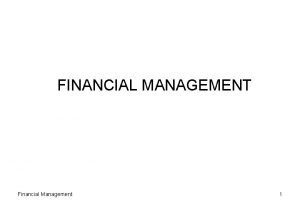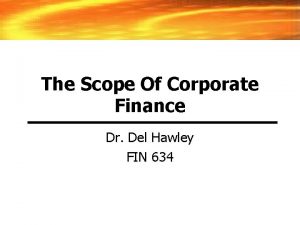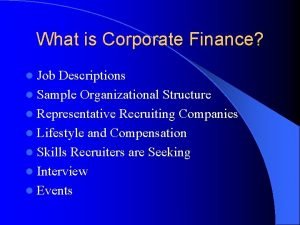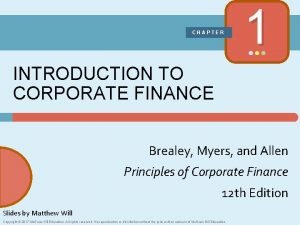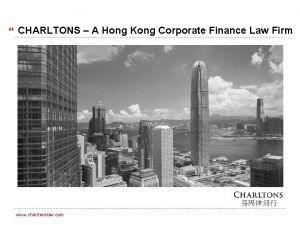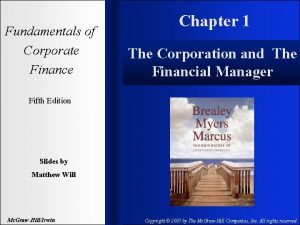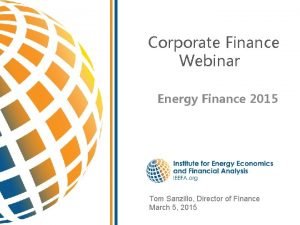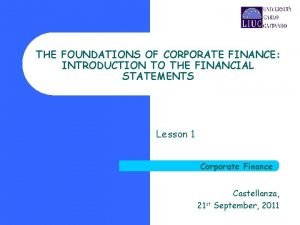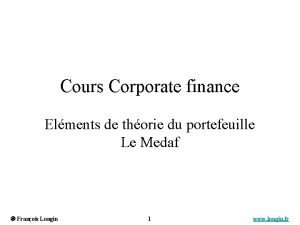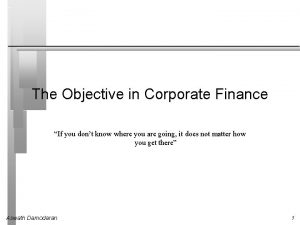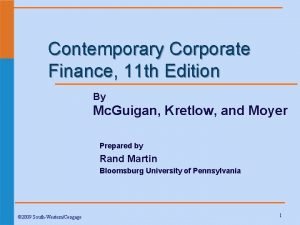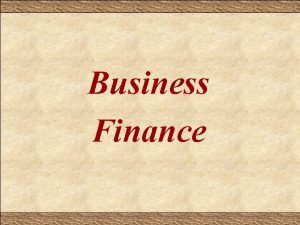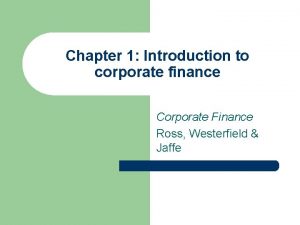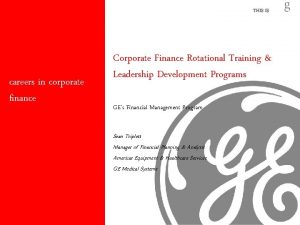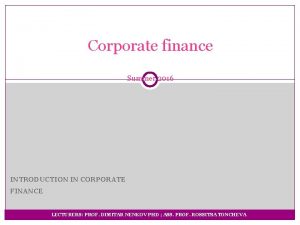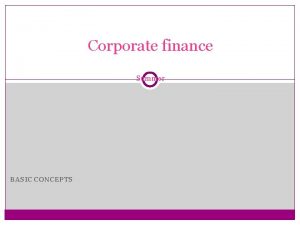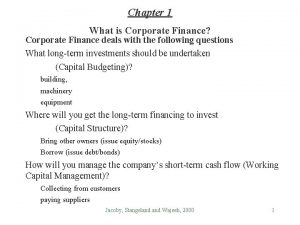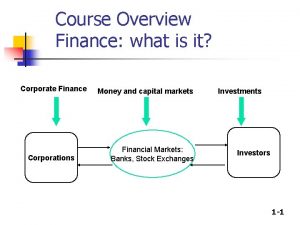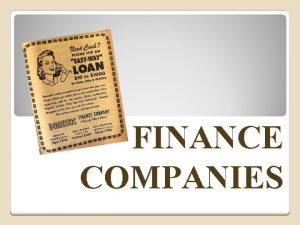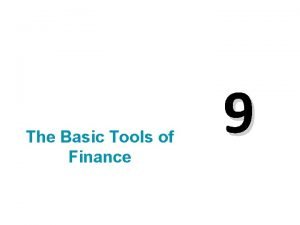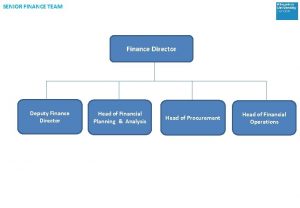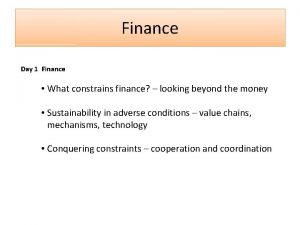Overview of Corporate Finance 1 What is Corporate








































- Slides: 40

Overview of Corporate Finance 1

What is Corporate Finance? (Q 1) • What kind of projects and/or business are you going to invest your firm’s money in? – Bayer selling an Alka-Seltzer factory for $1. • Annual maintenance: $6 -7 million • Removal cost: $20 million • Capital Budgeting – process of planning and managing a firm’s investment in physical or intangible assets – capital assets 2

What is Corporate Finance? (Q 2) • Where will you get the money? – Commercial Finance Co issued $750 million in 18 month floating rate (150 BP + 3 month LIBOR) – Stated purpose: Repurchase of AR or Acquisitions • Capital Structure Choice – choosing the mix of debt and equity used by a firm – capital liabilities 3

What is Corporate Finance? (Q 3) • How will you manage your financial activities? – Overnight money markets – Previous example: Issue notes to repurchase AR. • Working Capital Management – managing short-term operating cash flows – short term assets and liabilities 4

Main Activities of Financial Managers: Balance Sheet 5

The Goal of a Corporation • Possible Goals – Maximize sales? – Maximize earnings/profits? – Minimize risk/maximize risk? • Maximize the market value of shareholders equity 6

Wave I: Incoming MBA Wave II: After 1 st year Survey by the Aspen Institute 7 Wave III: Graduating MBA

How do we maximize shareholder wealth? ? ? Basic Principles 8

What is the value of any asset? Today’s value of expected future cash flows 9

What is the appropriate r? • . . . that r which reflects the riskiness of the cash flows • Conversion rate across time • Different ways to refers to r – Opportunity cost of capital – Required rate of return – Cost of capital – Appropriate discount rate – Hurdle rate – Capitalization rate – Etc. 10

Guiding Principle • Capital should be allocated to any project with a positive value • NPV>0: Is it really this simple? – Each investor wants to maximize wealth but is subject to different risk preferences and consumption patterns. – Efficient capital markets allow the investor to choose risk levels and time consumption. • Therefore, the corporate manager should just focus on maximizing wealth. 11

Is maximizing shareholder wealth optimal? • From a behavioral viewpoint is it a flawed design? • Is this goal sustainable and consistent? – “Maximizing”? – “Shareholder”? • Shareholders are the residual claimant – Risk and reward – “Wealth”? 12

Is maximizing shareholder wealth optimal? • From a societal point of view, is this a flawed design? – In the eyes of the benevolent social planner? • Is this goal sustainable and consistent? – “Maximizing”? – “Shareholder”? • Do shareholders deserve this right? – “Wealth”? 13

Value of the Corporation: Perfect World • where NPV is the stand alone, equity financed value of each project (p) and there are P total project(s) 14

What are other possible sources of value creation/destruction? • Capital structure – Created through market imperfections • Inter-project relationships (NPV’s are correlated) – Synergies – Diversification • Risk Management • Organizational Form/Incentive Structure – Agency issues 15

Why are there inconsistencies between management and finance? • Different cultures – Accounting numbers are what matters – All diversification is good – Do poor NPV projects for “strategic reasons” – “Greed is good” image • Discounted cash flow (DCF) is not trusted • DCF is not a perfect solution • ? ? ? 16

How can we manage these inconsistencies? • Communication • Intricate knowledge of DCF • Execute and manage DCF effectively – Scenario/Sensitivity analysis • Economics and Statistics – Common sense! • Identify what is causing NPV not to be near zero • Long run NPV should be zero – Manage bias: Cognitive and Motivational 17

Weakness in Finance Theory • r? – Difficult to estimate but probably the least critical to do with high precision • E(CF)? – Difficult to estimate incremental flows – Understand implications of increasing CF volatility • Time series decision making – DCF assumes nothing changes after the beginning of the project – Improve with real options framework 18

Organization of Economic Functions The firm is a way of organizing the economic activity of many individuals 19

Building Blocks: Individuals • REMM (Resourceful, Evaluative, Maximizing Model) – Every individual is an evaluator • Cares about everything • Willing to make tradeoff and substitutions – Are maximizing – Wants are unlimited – Are resourceful • Economic Model: reduced form of REMM, only maximize wealth • Other models: Sociological, Psychological and Political 20

Building Blocks: Firm • Forms – Sole proprietor – Partnership – Corporation • Nexus of contracts – Debt contracts: Claim on the firm’s assets and/or cash flows – Equity contracts: Claim on the firm’s residual assets and/or cash flows – Other stakeholder contracts: Customers, government, community, employees, etc. – Shareholders (principals) and management team (agents) contract 21

Corporation: A legal entity composed of one or more individuals or entities • Three distinct interests: separation of ownership and control – Shareholders (ownership, principal) – Board of Directors (control) – Top Management (implementation, agent) • Limited liability • Unlimited life • Transferable ownership • Corporation is a taxable entity – Distributions to shareholders are taxed again at the personal level 22

Potential Problems: Between Claimants • Information Asymmetry – Methods to manage: • Monitoring • Signaling • Agency Problems: Goals of the parties are not aligned – Agent someone who is hired to represent the principal’s interest – Equity: Potential conflict between shareholders and managers (principal-agent problem) • Traditional: Outside (non-management) shareholders • Overvalued equity – Debt: Potential conflict between shareholders and debt holders 23

Agency Problem of Outside Equity • Managers expropriate wealth from shareholders • Moral hazard problems – Effort aversion – Excessive perquisite consumption – Underinvestment due to risk aversion/short horizon – Entrenchment – Accept poor investment projects (NPV<0) • Empire building • Hubris • Free Cash Flow (FCF) Hypothesis (Jensen (1986)) 24

Examples of Agency Problems/Costs • Direct expropriation – Take cash out – Looting assets, low transfer pricing • Wide scale looting during Russian privatization • Indirect expropriation by non-optimal investing – – Empire building: excess firm expansion Hubris: incorrectly assessing an investments worth Underinvestment/Overinvestment Not maximizing shareholder wealth • Making poor capital budgeting decisions (incorrect method, execution, etc. ) • Decision making based on managers wealth maximization not shareholders • Inefficient actions – Shirking (too little effort) – Excess consumption of perks • Illegal actions – Misleading statements – Insider Trading 25

Ways to Manage Agency Problems • Board of Directors – Outsiders versus insiders, CEO/Chairman role – Size – Composition of audit, nominating and compensation committees • Firm’s voting structure – Dual class stocks – Concentrated versus Disperse Ownership – Outsiders versus Insiders • Incentives – Options, performance shares – Ownership of executive and directors • Takeover market – Antitakeover provisions, regulations – Ownership structure – Going private? • • Managerial labor market Judicial Review Government: New role of regulators? 26 Monitoring function: Debt, Institutional Investors, Blockholders

Agency Problem of Overvalued Equity • “Overvalued”: When management knows they can not sustain value • Managers more likely to behave sub-optimally – Target based corporate budgeting systems • Manipulation of both target and realized result – Skew preference for short term cash flows (earnings) – Excessive risk taking: Place high risk bets – Earnings management: More likely and higher error • Jensen (2005) 27

Earnings Game • CFO’s were asked if they were not on target for earnings which actions would they consider doing (Graham, Harvey & Rajgopal, 2004). – 80% would delay discretionary spending – 55% would sacrifice small value projects • Why do executive play this game? – – Favorable market conditions Stock based compensation Hubris/Egos Overvalued equity lets them buy at a “discount” • Analysts have become more of the process – High profile – High compensation/Hubris/Egos • Jensen and Fuller (2002) 28

Empirical evidence • Enron, Nortel and other companies • M&A’s: Large loss deals (>$1 billion lost) – For every $1 spent, they lost $2. 31 in shareholder wealth at the announcement (Moeller, Schlingemann and Stulz (2005)) 29

Manage Agency Problem of Overvalued Equity • Not an obvious, incentive based answer – Can’t buy an overvalued company, drop the stock price and make money • Possible solutions: – Long-run valuation incentives for management – Easier short selling – Improved governance – ? ? 30

Agency Problem of Debt • Equityholders expropriate wealth from debtholders • Moral hazard problems – Overinvestment, risk shifting, asset substitution – Debt overhang, underinvestment – Claim dilution – Take the money and run! 31

Debt can encourage excess risky investments Expected Profit=$200 with two possible outcomes Possible Outcomes: $100 or $300 Possible Outcomes: $0 or $400 • Realized Profit = $100 – – Debt: $50 Management: $30 Employees: $20 Shareholders: $0 • Realized Profit = $0 – – • 100 -50 -30 -20 =0 Debt: $0 Management: $0 Employees: $0 Shareholders: $0 • 0 -50 -30 -20=-100 – BANKRUPT! • Realized Profit = $300 – – Debt: $50 Management: $30 Employees: $20 Shareholders: $200 • 300 -50 -30 -20 = 200 • Realized Profit = $400 – – Debt: $50 Management: $30 Employees: $20 Shareholders: $300 • 400 -50 -30 -20 = 300 32

Manage Agency Problem of Debt • Protective Debt covenants • Restrictions on – Investment and disposition of assets – Shareholder payouts – Issuance of more senior debt • Security design – Convertible debt – Callable debt (reduce probability of underinvestment) 33

Elements of Effective Governance • Ownership and Control: Incentive versus Entrenchment • Monitoring: What makes an effective monitor? • Signaling: What makes the signal more credible? – Costly – Verifiable 34

Empirical Evidence: Effective Governance • Board Composition: Should have a majority of outside directors, i. e. independent board – For specific events, the firm performs better • Independent board acquirer outperforms (-0. 07% compared to 1. 86%, announcement return) • Independent board target outperforms (62. 3% compared to 40. 9%, inception to completion) • CEO/Chairman should be separate role – Only tested in large companies Number of boards a director sits on • Number of boards a director sits on – Reasonable number of boards are fine for directors with strong reputations/skills 35

Effective Governance • Board committees: audit, nominating, and compensation – Some evidence that independent audit committees make earnings announcements more reliable – Perceived positively when CEO is not influential in director nominations • Board size – Bigger boards are more dysfunctional (<8 outperformed >14 based on multiples) – Announcement of significant size decrease, stock price increases by 2. 9% (conversely, size increase, price decreases by 2. 8%) 36

Effective Governance: Compensation • Compensation Structure – Salary: Too High? Too Low? Perverse Incentives? – Bonuses: Fair? Unfair? • Levels • Timing • Option compensation – In general seems to be a good policy (for managers and directors) – There are instances where large option grants appear to be timed before favorable announcements – Firm’s with high option holdings may increase exposure to total risk 37

Governance: Concentrated Ownership • Large shareholders provide a monitoring function for smaller, disperse shareholders • Large shareholders may behave sub-optimally – May control too much and discourage management from behaving optimally – May control the firm to their personal wealth management • Timing • Assume less risk because they are not well diversified – Higher likelihood of expropriation, capturing private benefits • What if the large shareholders are also top management (insider ownership)? – Entrenchment Effect: Greater likelihood of behaving suboptimally – Incentive Effect: Goals are aligned with other shareholders 38

Is there an optimal level of managerial/concentrated ownership? • Ownership level doesn’t affect value – Level of ownership is a joint optimization of ownership and value • For example, 5% ownership is not always better than 10% – Changes will not increase value (et. al. , Demsetz, 1983) • All firms are currently at the optimal level so any change, all else being equal, would decrease value • Ownership level affects value – Level and changes in ownership matters • Ownership<5%: Value increases with increase in ownership • 5%>Ownership<25%: Value decreases with increase in ownership • Ownership>25%: Value increase with increase in ownership – Morck, Schleifer and Vishney (1988) – Curvilinear relationship: Value increases in ownership up to a point after which further increases in ownership reduce value • Mc. Connell, Servaes and Lins (2003) http: //papers. ssrn. com/sol 3/papers. cfm? abstract_id=470927#Paper. Download 39

Governance: Too Little, Too Late? • U. S. Markets – Liquidity (Investor Protection) versus Governance (Bhide (1994)) – Insider ownership, disclosure rules – Blockholder and Institutional regulation and constraints don’t allow for concentrated ownership • Other countries: Japan and Germany – Blockholders account for 20% of market capitalization – Close relationship between large shareholders, debtholders and management • Solutions? – Non-public markets – Change regulations 40
 Corporate finance overview
Corporate finance overview Examples of agency problems
Examples of agency problems Objective of corporate finance
Objective of corporate finance Overview of personal finance chapter 1
Overview of personal finance chapter 1 Texas public school finance overview
Texas public school finance overview Foundations in personal finance chapter 1 summary answers
Foundations in personal finance chapter 1 summary answers Texas public school finance overview
Texas public school finance overview Objective of corporate finance
Objective of corporate finance Conservation of corporate finance
Conservation of corporate finance Chapter 1 introduction to corporate finance
Chapter 1 introduction to corporate finance Fundamentals of corporate finance chapter 6 solutions
Fundamentals of corporate finance chapter 6 solutions Principles of corporate finance chapter 3 solutions
Principles of corporate finance chapter 3 solutions Multinational corporate finance
Multinational corporate finance Chapter 1 introduction to corporate finance
Chapter 1 introduction to corporate finance Chapter 1 introduction to corporate finance
Chapter 1 introduction to corporate finance Damodaran beta
Damodaran beta Maastricht university ib
Maastricht university ib Corporate finance tenth edition
Corporate finance tenth edition Behavioral corporate finance shefrin
Behavioral corporate finance shefrin Corporate finance bonds
Corporate finance bonds Fundamentals of corporate finance third canadian edition
Fundamentals of corporate finance third canadian edition Corporate finance syllabus
Corporate finance syllabus Modern finance theory
Modern finance theory Scope of corporate finance
Scope of corporate finance Afm 372
Afm 372 Corporate finance job scope
Corporate finance job scope Chapter 1 introduction to corporate finance
Chapter 1 introduction to corporate finance Charltons law
Charltons law Fundamentals of corporate finance, chapter 1
Fundamentals of corporate finance, chapter 1 Corporate finance tenth edition
Corporate finance tenth edition Fundamentals of corporate finance, chapter 1
Fundamentals of corporate finance, chapter 1 Corporate finance webinar
Corporate finance webinar Fundamentals of corporate finance fifth edition
Fundamentals of corporate finance fifth edition Foundations of corporate finance
Foundations of corporate finance Objective of corporate finance
Objective of corporate finance Corporate finance tenth edition
Corporate finance tenth edition Corporate finance cours
Corporate finance cours Objective of corporate finance
Objective of corporate finance Corporate finance 6th edition
Corporate finance 6th edition Corporate finance tenth edition
Corporate finance tenth edition Contemporary corporate finance
Contemporary corporate finance

